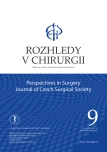Giant peritoneal loose body – case report
Authors:
M. Rykovský 1; M. Michal 2,3
Authors‘ workplace:
Chirurgické oddělení Fakultní nemocnice Plzeň, Česká republika
1; Šiklův ústav patologie Lékařské fakulty Univerzity Karlovy v Plzni a Fakultní nemocnice Plzeň, Česká republika
2; Bioptická laboratoř s. r. o., Plzeň, Česká Republika
3
Published in:
Rozhl. Chir., 2023, roč. 102, č. 9, s. 366-370.
Category:
Case Reports
doi:
https://doi.org/10.33699/PIS.2023.102.9.366–370
Overview
The article presents the case of a rare, free moving, completely benign intra-abdominal formation called “giant peritoneal loose body”. In our case, an expansion of the left hypogastrium with central calcification, in intimate contact with intestinal loops, of rather benign etiology, reminiscent of a mesenteric calcifying fibrous tumor, was accidentally detected on CT angiography. A possible neoplastic process was suspected, and therefore PET/CT was completed, showing that the expansion had moved to the right hypogastrium, and the radiologist evaluated the finding as a possible teratoma not originating from an intestinal loop. Due to the still indeterminate nature of the expansion, an exploratory laparotomy was performed with the discovery of a loose ovoid mass without any vascular supply and unrelated to other structures, which was extracted and sent for histological examination. The result was surprising. According to the pathologist, it was a rare, completely benign intra-abdominal lesion called the “giant peritoneal loose body”. This pseudotumor should be considered as a differential diagnosis whenever we accidentally detect an asymptomatic, freely moving intra-abdominal lesion with central necrosis or calcification, in order to avoid unnecessary surgery, because according to available information, only symptomatic ones should be surgically removed.
Keywords:
giant peritoneal loose body – epiploic appendices – boiled egg – abdominal stalactite
Sources
1. Hyun-Soo Kim, Ji-Youn Sung, Won Seo Park, et al. A giant peritoneal loose body. The Korean Journal of Pathology 2013 Aug;47(4):378–382. doi:10.4132/KoreanJPathol.2013.47.4.378.
2. Joung Teak Jang, Haeng Ji Kang, Ji 4. Young Yoon, et al. Giant peritoneal loose body in the pelvic cavity. Journal of the Korean Society of Coloproctology 2012;28(2):108–110. doi:10.3393/jksc.2012.28.2.108.
3. Pezhouh MK, Rezaei MK, Shabihkhani M, et al. Clinicopathologic study of calcifying fibrous tumor of the gastrointestinal tract: a case series. Hum Pathol. 2017 Apr;62:199–205. doi:10.1016/j.humpath. 2017.01.002. Epub 2017 Jan 30.
4. Agaimy A, Bihl MP, Tornillo L, et al. Calcifying fibrous tumor of the stomach: clinico pathologic and molecular study of seven cases with literature review and reappraisal of histogenesis. Am J Surg Pathol. 2010 Feb;34(2):271–278. doi:10.1097/ PAS.0b013e3181ccb172.
5. Takada A, Moriya Y, Muramatsu Y, et al. A case of giant peritoneal loose bodies mimicking calcified leiomyoma originating from the rectum. Jpn J Clin Oncol. 1998 Jul;28(7):441–442. doi:10.1093/ jjco/28.7.441.
6. Ghosh P, Strong C, Naugler W, et al. Peritoneal mice implicated in intestinal obstruction: report of a case and review of the literature. J Clin Gastroenterol. 2006 May–Jun;40(5):427–430. doi:10.1097/00004836-200605000-00012.
MUDr. Michal Rykovský
Chirurgické oddělení FN Plzeň
e-mail: rykovskym@fnplzen.cz
ORCID:0009-0000-6597-5229
Labels
Surgery Orthopaedics Trauma surgeryArticle was published in
Perspectives in Surgery

2023 Issue 9
Most read in this issue
- Treatment of the congenital thoracic deformity pectus excavatum
- Triple neurectomy following Lichtenstein repair of inguinal hernia
- Blood loss during HPB procedures
- Giant peritoneal loose body – case report
